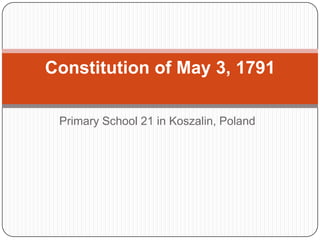
Constitution
- 1. PrimarySchool 21 in Koszalin, Poland Constitution of May 3, 1791
- 2. Constitution of May 3, 1791 Constitution of May 3, 1791 is generally regarded as Europe's first and the world's second modern codified national constitution, following the 1788 ratification of the United States Constitution. The May 3, 1791, Constitution was adopted as a "Government Act" on that date by the Sejm (parliament) of the Polish–Lithuanian Commonwealth.
- 3. The May 3 Constitution was designed to redress long-standing political defects of the Polish–Lithuanian Commonwealth and its traditional system of "Golden Liberty" conveying disproportionate rights and privileges to the nobility. The Constitution introduced political equality between townspeople and nobility and placed the peasants under the protection of the government,thus mitigating the worst abuses of serfdom. The Constitution abolished pernicious parliamentary institutions such as the liberum veto, which at one time had put the sejm at the mercy of any deputy who might choose, or be bribed by an interest or foreign power, to undo legislation passed by that sejm. The Constitution sought to supplant the existing anarchy fostered by some of the country's magnates with a more democraticconstitutional monarchy.The document was translated into Lithuanian. The adoption of the May 3 Constitution provoked the active hostility of the Commonwealth's neighbors. In the War in Defense of the Constitution, the Commonwealth lost.
- 4. May 3 Constitution, by Matejko (1891). King Stanisław August (left) enters St. John's Cathedral, where deputies will swear to uphold the Constitution. Background: Warsaw's Royal Castle, where it has just been adopted.
- 5. Background By the early 17th century, the magnates of Poland and Lithuania controlled the Commonwealth—or rather, they managed to ensure that no reforms would be carried out that might weaken their privileged status (the "Golden Freedoms"). They spent lavishly on banquets, drinking bouts and other amusements, while the peasants languished in abysmal conditions and the towns, many of which were wholly within the private property of a magnate who feared the rise of an independent middle class, were kept in a state of ruin. The Enlightenment had gained great influence in certain Commonwealth circles during the reign (1764–95) of its last king, Stanisław August Poniatowski, and the King had proceeded with cautious reforms such as the establishment of fiscal and military ministries and a national customs tariff.
- 7. Accordingly Russia's Empress Catherine the Great and Prussia's King Frederick the Great provoked a conflict between some members of the Sejm and the King over civil rights for religiou minorities. Catherine and Frederick declared their support for the Polish nobility (szlachta) and their "liberties," and by October 1767 Russian troops had assembled outside the Polish capital, Warsaw. The King and his adherents, in face of superior Russian military force, were left with little choice but to acquiesce in Russian demands and during the RepninSejm (named after unofficially presiding Russian ambassador Nicholas Repnin) accept the five "eternal and invariable principles" which Catherine vowed to "protect for all time to come in the name of Poland's liberties„. Polish-Lithuanian Commonwealth 1789-1792, after removal of Russian Empire protectorate
- 8. On February 29, 1768, several magnates, including KazimierPułaski, vowing to oppose Russian intervention, declared Stanisław August a "lackey of Russia and Catherine" and formed a confederation at the town of Bar. The Bar Confederation began a civil war with the goal of overthrowing the King and fought on until 1772, when overwhelmed by Russian intervention. The Bar Confederation's defeat set the scene for the next act in the unfolding drama. On August 5, 1772, at St. Petersburg, Russia, the three neighboring powers—Russia, Prussia and Austria—signed the First Partition treaty. The Polish–Lithuanian Commonwealth was to be divested of about a third of its territory and population (over 200,000 km2 (77,220 sq mi) and 4 million people).
- 9. Rejtan, by Matejko. In September 1773, Rejtan (lower right) tried to prevent ratification of the First Partition of the Polish-Lithuanian Commonwealth by barring other Sejm deputies from the chamber.
- 10. In 1791, the "Great" or Four-Year Sejm of 1788–92 adopted the May 3 Constitution at Warsaw's Royal Castle.
- 12. The Constitution remained in effect for only a year before being overthrown, by Russian armies allied with the Targowica Confederation, in the War over the May 3, 1791, Constitution.
- 13. Holiday May 3 was first declared a holidayon May 5, 1791. Banned during the partitions of Poland (though still then occasionally celebrated) celebrated in the Duchy of Warsaw. It was again made an official Polish holiday in April 1919 under the Second Polish Republic—the first holiday officially introduced in the Second Polish Republic. The May 3 holiday was banned once more during World War II by the Nazi and Soviet occupiers.
- 14. After the 1946 anti-communist student demonstrations, May 3 Constitution Day lost support with the authorities of the Polish People's Republic, who replaced it with May 1 Labor Day celebrations. Until 1989, May 3 was a common day for anti-government and anti-communist protests. May 3 was restored as an official Polish holiday in April 1990, after the fall of communism. In 2007, May 3 was in addition declared a Lithuanian national holiday. The first joint celebration by the Polish Sejm and the Lithuanian Seimas took place on May 3, 2007. TheEnd
- 15. Made By: Arkadiusz P.